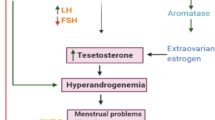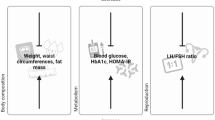Abstract
Benign prostatic hyperplasia (BPH) is the most common nonmalignant condition of the prostate occurring in ageing men. Even though BPH is a major public health problem, causing high morbidity and substantial worsening in men’s quality of life, little is known about its risk factors. Several studies revealed that it is a multifactorial disease. Previous studies have documented family history, hormonal imbalance, and growth factors as etiological factors in the development of BPH. This review focuses on the dietary and metabolic risk factors including diabetes mellitus, hypertension, obesity, hyperinsulinemia, as well as dyslipidemia and their mechanisms in the pathogenesis of BPH.

Similar content being viewed by others
Abbreviations
- BPH:
-
Benign prostatic hyperplasia
- EPA:
-
Eicosapentaenoic acid
- DHA:
-
Docosahexaenoic acid
- DHT:
-
Dihydrotestosterone
- LUTS:
-
Lower urinary tract symptoms
- HIF:
-
Hypoxia inducible factor
- VEGF:
-
Vascular endothelial growth factor
- FGF:
-
Fibroblast growth factors
- IL:
-
Interleukin
- BMI:
-
Body mass index
- WHR:
-
Waist-to-hip ratio
- SHR:
-
Spontaneously hypertensive rats
- PSA:
-
Prostate specific antigen
- IHD:
-
Ischemic heart disease
- IGF:
-
Insulin-like growth factor
- LDL:
-
Low density lipoprotein
- HDL:
-
High density lipoprotein
References
Berry SJ, Coffey DS, Walsh PC et al (1984) The development of human benign prostatic hyperplasia with age. J Urol 132:474–479
Ziada A, Rosenblum M, Crawford ED (1999) Benign prostatic hyperplasia: an overview. Urology 53(3):1–6
Barry JM (1990) Epidemiology and natural history of BPH. Urol Clin North Am 17(3):495–507
Partin AW, Oesterling JE et al (1991) Influence of age and endocrine factors on the volume of benign prostatic hyperplasia. J Urol 145(2):405–409
Sanda MG, Beaty TH, Stutzman RE et al (1994) Genetic susceptibility of benign prostatic hyperplasia. J Urol 152:115–119
Golda R, Wolski Z, Wyszomirska-Golda M et al (2004) The presence and structure of circulating immune complexes in patients with prostate tumors. Med Sci Monit 10:CR123–CR127
Sinowatz F, Amselgruber W, Plendl J et al (1995) Effects of hormones on the prostate in adult and aging men and animals. Microsc Res Tech 30:282–292
Griffiths K, Denis L, Turkes A et al (1998) Phytoestrogens and diseases of the prostate gland. Baillieres Clin Endocrinol Metab 12:625–647
Kolle S, Sinowatz F, Boie G et al (1999) Expression of growth hormone receptor in human prostatic carcinoma and hyperplasia. Int J Oncol 14:911–916
Leav I, Merk FB, Lee KF (1999) Prolactin receptor expression in the developing human prostate and in hyperplastic, dysplastic, and neoplastic lesions. Am J Pathol 154:863–870
Stattin P, Kaaks R, Riboli E et al (2001) Circulating insulin-like growth factor-I and benign prostatic hyperplasia—a prospective study. Scand J Urol Nephrol 35:122–126
Wang FL, Wang H, Qin WJ et al (2004) Expression and its significance of b-FGF in human benign prostatic hyperplasia and prostatic carcinoma tissues. Xi Bao Yu Fen Zi Mian Yi Xue Za Zhi 20:203–205
Wolff JM, Fandel T, Borchers H et al (1998) Transforming growth factor-beta1 serum concentration in patients with prostatic cancer and benign prostatic hyperplasia. Br J Urol 81:403–405
Suzuki S, Platz EA, Kawachi I et al (2002) Intakes of energy and macronutrients and the risk of benign prostatic hyperplasia. Am J Clin Nutr 75:689–697
Gu F (1997) Changes in the prevalence of benign prostatic hyperplasia in China. Chin Med J 110:163–166
Araki H, Watanabe H, Mishina T et al (1983) High-risk group for benign prostatic hypertrophy. Prostate 4:253–264
Denis L, Morton MS, Griffiths K (1999) Diet and its preventive role in prostatic disease. Eur Urol 35:377–387
Troisi RJ, Weiss ST, Parker DR et al (1991) Relation of obesity and diet to sympathetic nervous system activity. Hypertension 17:669–677
Augustin LS, Franceschi S, Jenkins DJ (2002) Glycemic index in chronic disease: a review. Eur J Clin Nutr 56:1049–1071
Chokkalingam AP, Gao YT, Deng J (2002) Insulin-like growth factors and risk of benign prostatic hyperplasia. Prostate 52:98–105
Bostwick D (1996) Pathology of benign prostatic hyperplasia. In: Kirby R, McConnell J, Fitzpatrick J et al (eds) Textbook of benign prostatic hyperplasia. ISIS Medical Media, Ltd, Oxford, pp 91–104
Liang T, Liao S (1992) Inhibition of steroid 5α-reductase by specific aliphatic unsaturated fatty acids. Biochem J 285:557–562
Weisser H, Krieg M (1998) Fatty acid composition of phospholipids in epithelium and stroma of human benign prostatic hyperplasia. Prostate 36:235–243
Boon TA, Van Venrooji GE, Eckhardt MD (2001) Effect of diabetes mellitus on lower urinary tract symptoms and dysfunction in patients with benign prostatic hyperplasia. Curr Urol Rep 2(4):297–301
Michel MC, Mehlburger L, Schumacher H et al (2000) Effect of diabetes on lower urinary tract symptoms in patients with benign prostatic hyperplasia. J Urol 163:1725–1729
Hammarsten J, Hogstedt B (2001) Hyperinsulinemia as a risk factor for developing benign prostatic hyperplasia. Eur Urol 39:151–158
Berger AP, Deibel M, Halpern EJ et al (2005) Vascular damage induced by type 2 diabetes mellitus as a risk factor for benign prostatic hyperplasia. Diabetologia 48:784–789
Ghafar MA, Puchner PJ, Anastasiadis AG et al (2002) Does the prostate vascular system contribute to the development of benign prostatic hyperplasia? Curr Urol Rep 3:292–296
Loran OB, Vishnevskii EL, Vishnevskii AE (1996) The role of detrusor hypoxia in the pathogenesis of urination disorders in patients with benign prostatic hyperplasia. Urol Nefrol 6:33–37
Berger AP, Kofler K, Bektic J et al (2003) Increased growth factor production in a human prostatic stromal cell culture model caused by hypoxia. Prostate 57:57–65
Palmer LA, Semenza GL, Stoler MH et al (1998) Hypoxia induces type II NOS gene expression in pulmonary artery endothelial cells via HIF-1. Am J Physiol 274:212–219
Dahle ES, Chokkalingam AP, Gao Y-T et al (2002) Body size and serum levels of insulin and leptin in relation to the risk of benign prostatic hyperplasia. J Urol 168:599–604
Hammarsten J, Hogstedt B (1999) Clinical, anthropometric, metabolic and insulin profile of men with fast annual growth rates of benign prostatic hyperplasia. Blood Press 8:29–36
Giovannucci E, Rimm EB, Chute CG et al (1994) Obesity and benign prostatic hyperplasia. Am J Epidemiol 140(11):989–1002
Furukawa S, Fujita T, Shimabukuro M (2004) Increased oxidative stress in obesity and its impact on metabolic syndrome. J Clin Invest 114:1752–1761
Nickel JC, Downey J, Young I et al (1999) Asymptomatic inflammation and/or infection in benign prostatic hyperplasia. BJU Int 84:976–981
Di Silverio F, Gentile V, De Matteis A (2003) Distribution of inflammation, pre-malignant lesions, incidental carcinoma in histologically confirmed benign prostatic hyperplasia: a retrospective analysis. Eur Urol 43:164–175
Ivleva AI, Sivkov AV (2000) Treatment of arterial hypertension in patients with benign prostatic hyperplasia. Urologia 1:6–11
Steers WD, Clemow DB, Persson K et al (1999) The spontaneously hypertensive rat: insight into the pathogenesis of irritative symptoms in benign prostatic hyperplasia and young anxious males. Exp Physiol 84(1):137–147
Guo LJ, Zhang XH, Li PJ et al (2005) Association study between benign prostatic hyperplasia and primary hypertension. Zhonghua Wai Ke Za Zhi 43(2):108–111
Guthrie RM, Siegel RL (1999) A multicenter, community-based study of doxazin in the treatment of concomitant hypertension and symptomatic benign prostatic hyperplasia: the hypertension and BPH intervention trial. Clin Ther 21(10):1732–1748
Steers WD, Clemow DB, Persson K et al (1999) The spontaneously hypertensive rats: insight into the pathogenesis of irritative symptoms in benign prostatic hyperplasia and young anxious males. Exp Physiol 84:137–147
Lujan M, Ferruelo A, Paez A et al (2004) Prostate apoptosis after doxazin treatment in the spontaneous hypertensive rat model. BJU Int 93(3):410–414
Achari R, Hosmane B, Bonacci E et al (2000) The relationship between terazosin dose and blood pressure response in hypertensive patients. J Clin Pharmacol 40:1166–1172
Esler M, Rumantir M, Kaye D (2001) Sympathetic nerve biology in essential hypertension. Clin Exp Pharmacol Physiol 28:986–989
Guo LJ, Zhang XH, Li PJ et al (2005) Impact of hypertension on angiogenesis in the tissues of benign prostatic hyperplasia. Zhonghua Yi Xue Za Zhi 85(9):606–609
Weisman KM, Larijani GE, Goldstein MR et al (2000) Relationship between benign prostatic hyperplasia and history of coronary artery disease in elderly men. Pharmacotherapy 20(4):383–386
Aliaev IuG, Fiev DN, Kopvlov FIu et al (2005) Treatment of benign prostatic hyperplasia in patients with ischemic heart disease. Urologia 1:12–18
Berger AP, Bartsch G, Deibl M et al (2006) Atherosclerosis as a risk factor for benign prostatic hyperplasia. BJU Int 98(5):1038–1042
Azadzoi KM, Tarcan T, Siroky MB et al (1999) Atherosclerosis-induced chronic ischemia causes bladder fibrosis and non-compliance in the rabbit. J Urol 161:1626–1635
Reaven GM (1988) Banting lecture 1988. Role of insulin resistance in human disease. Diabetes 37(12):1595–1607
Li L, Yang G, Li Q et al (2006) High fat and lipid induced insulin resistance in rats: the comparison of glucose metabolism, plasma resistin and adiponectin levels. Ann Nutr Metab 50(6):499–505
Reaven GM (1992) The role of insulin resistance and hyperinsulinemia in coronary heart disease. Metabolism 41:16–19
Nandeesha H, Koner BC, Dorairajan LN et al (2006) Hyperinsulinemia and dyslipidemia in non diabetic benign prostatic hyperplasia. Clin Chim Acta 370:89–93
Morgan DA, Balon TW, Ginsberg BH et al (1993) Nonuniform regional sympathetic nerve responses to hyperinsulinemia in rats. Am J Physiol 264:R423–R427
Hautanen A (2000) Synthesis and regulation of sex hormone-binding globulin in obesity. Int J Obes Relat Metab Disord 24:S64
Peehl DM, Cohen P, Rosenfeld RG (1996) The role of insulin-like growth factors in prostate biology. J Androl 17:2–4
Stattin P, Kaaks R, Riboli E et al (2001) Circulating insulin-like growth factor -1 and benign prostatic hyperplasia: a prospective study. Scand J Urol Nephrol 35:122
Lee E, Park MS, Shin C (1997) A high-risk group for prostatism: a population-based epidemiological study in Korea. Br J Urol 79:736–741
Li PJ, Zhang XH, Guo LJ et al (2005) Correlation of benign prostatic hyperplasia with hyperlipemia. Zhonghua Wai Ke Za Zhi 43(6):387–389
Bagatell CJ, Knopp RH, Vale WW et al (1992) Physiologic testosterone levels in normal men suppress HDL-cholesterol levels. Ann Int Med 116:967–973
Kondo A, Li J, Manabe M et al (2003) Relationship between high-density lipoprotein-cholesterol and malondialdehyde-modified low-density lipoprotein concentrations. J Atheroscler Thromb 10:72–78
Sakai M, Kobori S, Miyazaki A et al (2000) Macrophage proliferation in atherosclerosis. Curr Opin Lipidol 11(5):503–509
Author information
Authors and Affiliations
Corresponding author
Rights and permissions
About this article
Cite this article
Nandeesha, H. Benign prostatic hyperplasia: dietary and metabolic risk factors. Int Urol Nephrol 40, 649–656 (2008). https://doi.org/10.1007/s11255-008-9333-z
Received:
Accepted:
Published:
Issue Date:
DOI: https://doi.org/10.1007/s11255-008-9333-z




